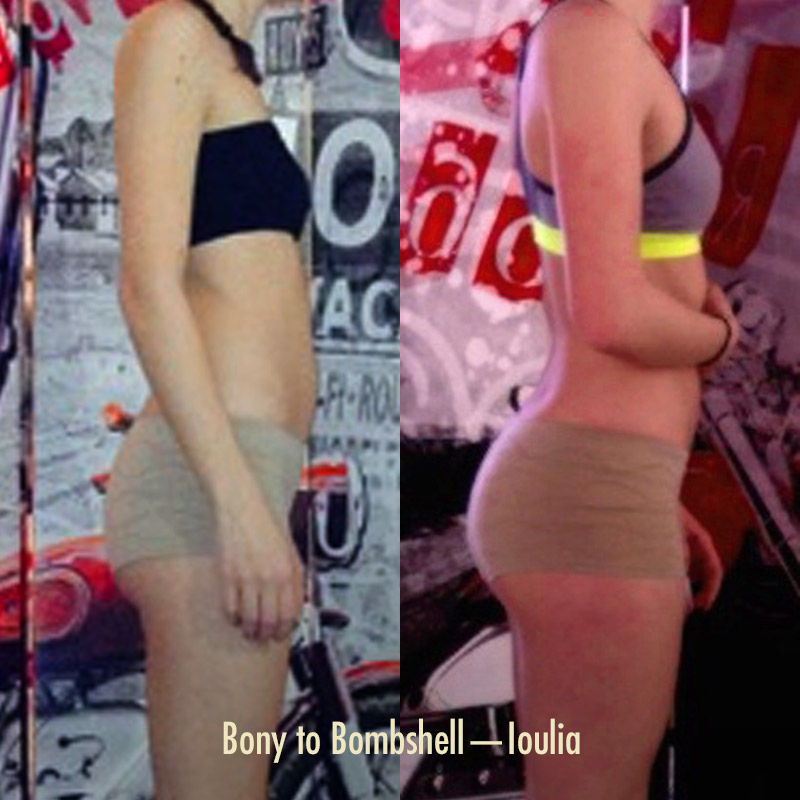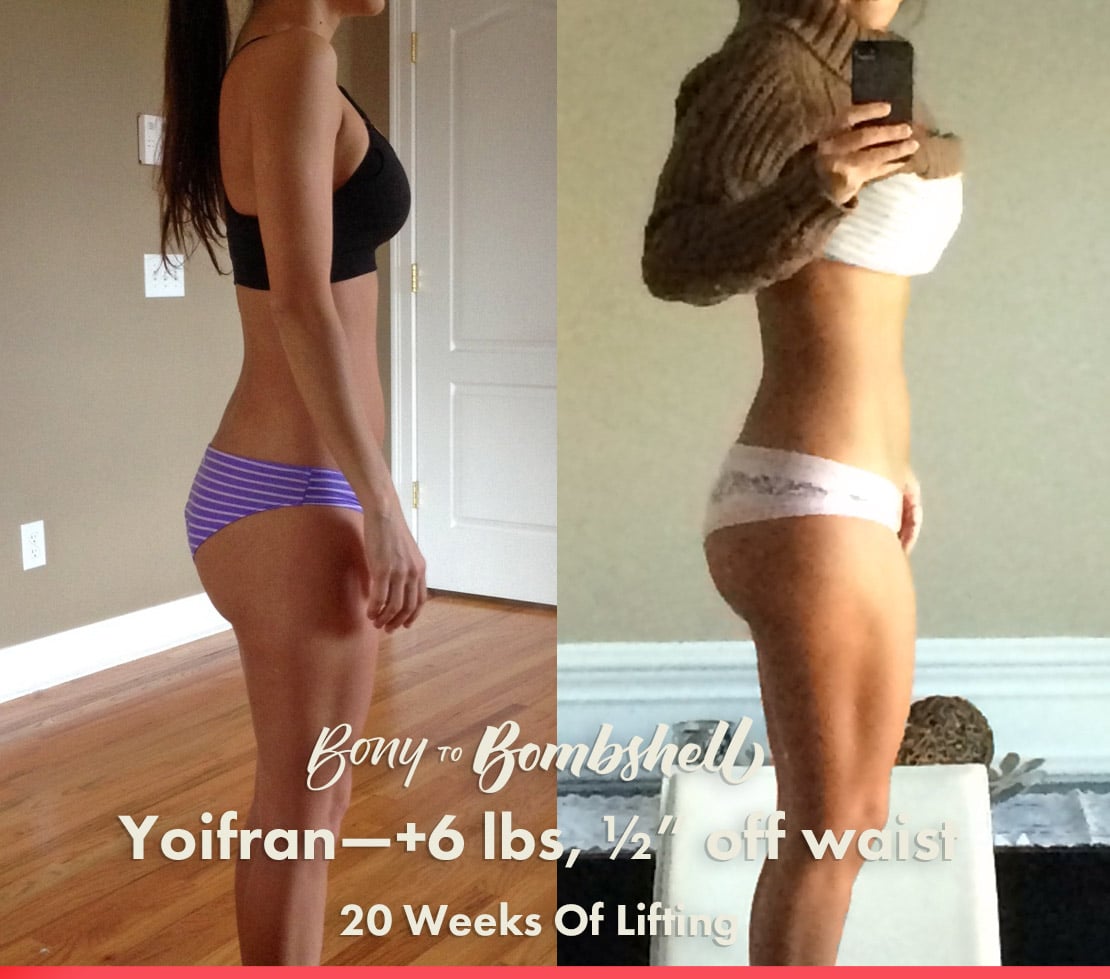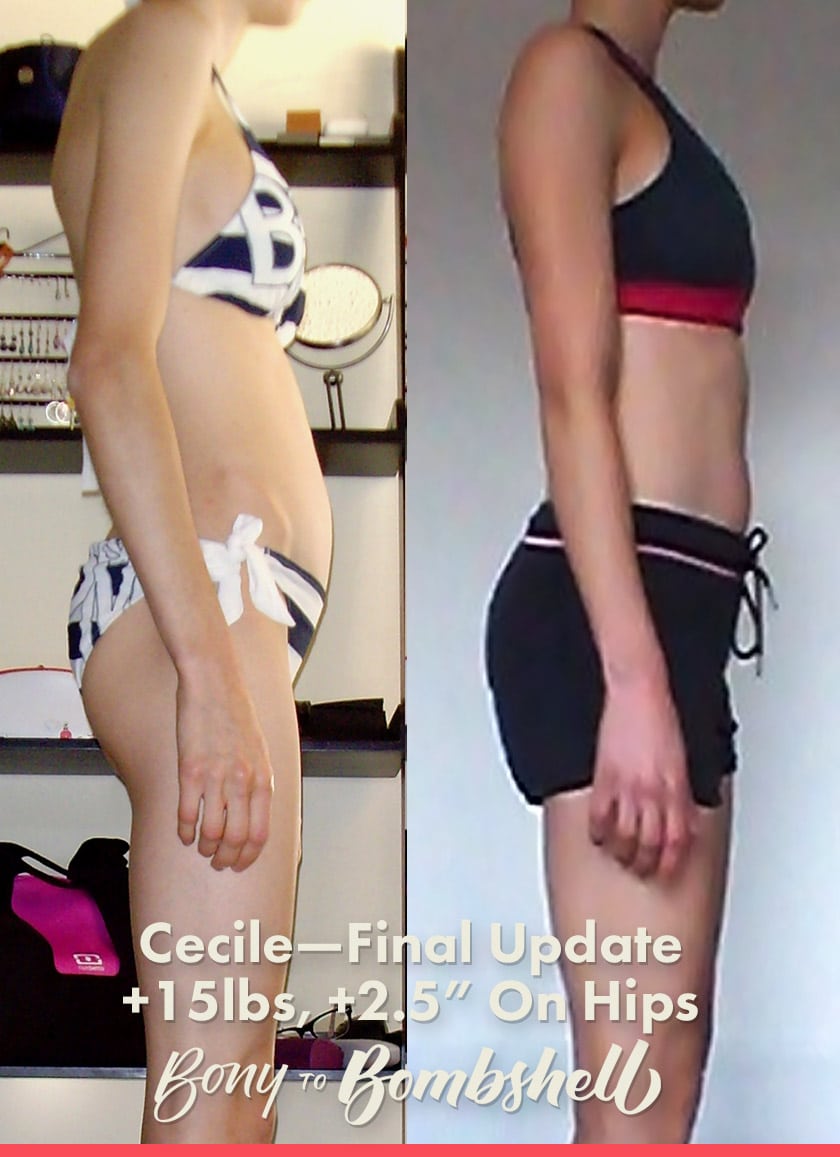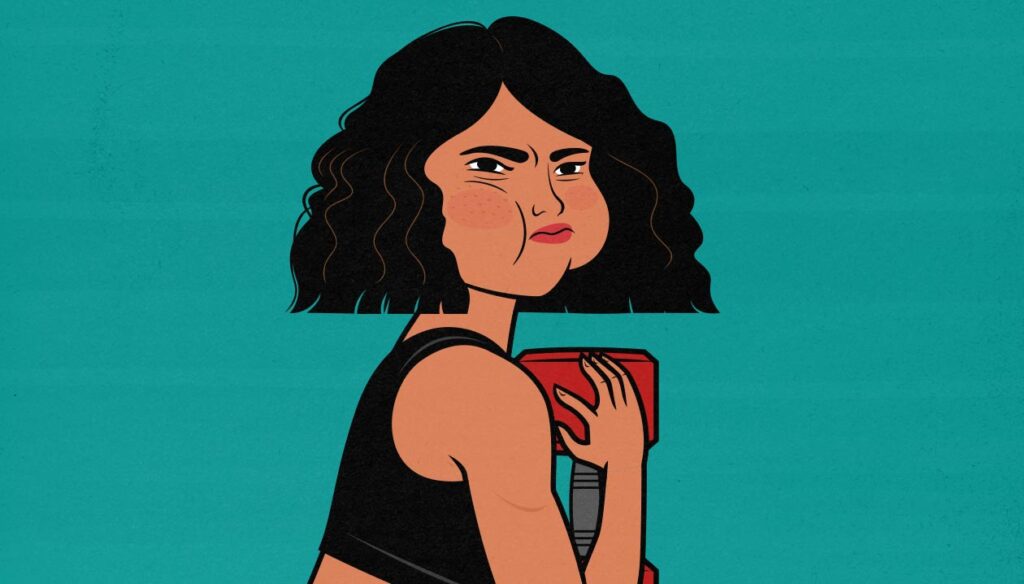
Beginner Muscle-Building Workout Plan for Women (Home or Gym)
This is a 3-day full-body muscle-building routine for women just starting out or just getting back into lifting weights. You can do it in your living room with adjustable dumbbells, in your basement with a barbell home gym, or with a full gym membership.
This is a beginner routine, but that doesn’t mean we aren’t serious about it. Marco has experience training some of the best female athletes in the world, including women on our Olympic rugby team.
The workouts are designed to stimulate muscle growth, which makes them perfect for gaining weight and building muscle, but you could take this one of three ways:
- Bulking: If you’re gaining weight, this workout program will help keep your gains lean.
- Cutting: If you’re losing weight, this workout program will maintain your muscle mass, allowing you to burn pure fat. You may even gain a small amount of muscle.
- Recomping: If you’re skinny fat, you can build muscle while burning fat. This workout program will stimulate muscle growth, and your body will pull the energy it needs from your fat stores.
I’ll explain the workout routine, and Marco will teach you the exercises with tutorial videos.
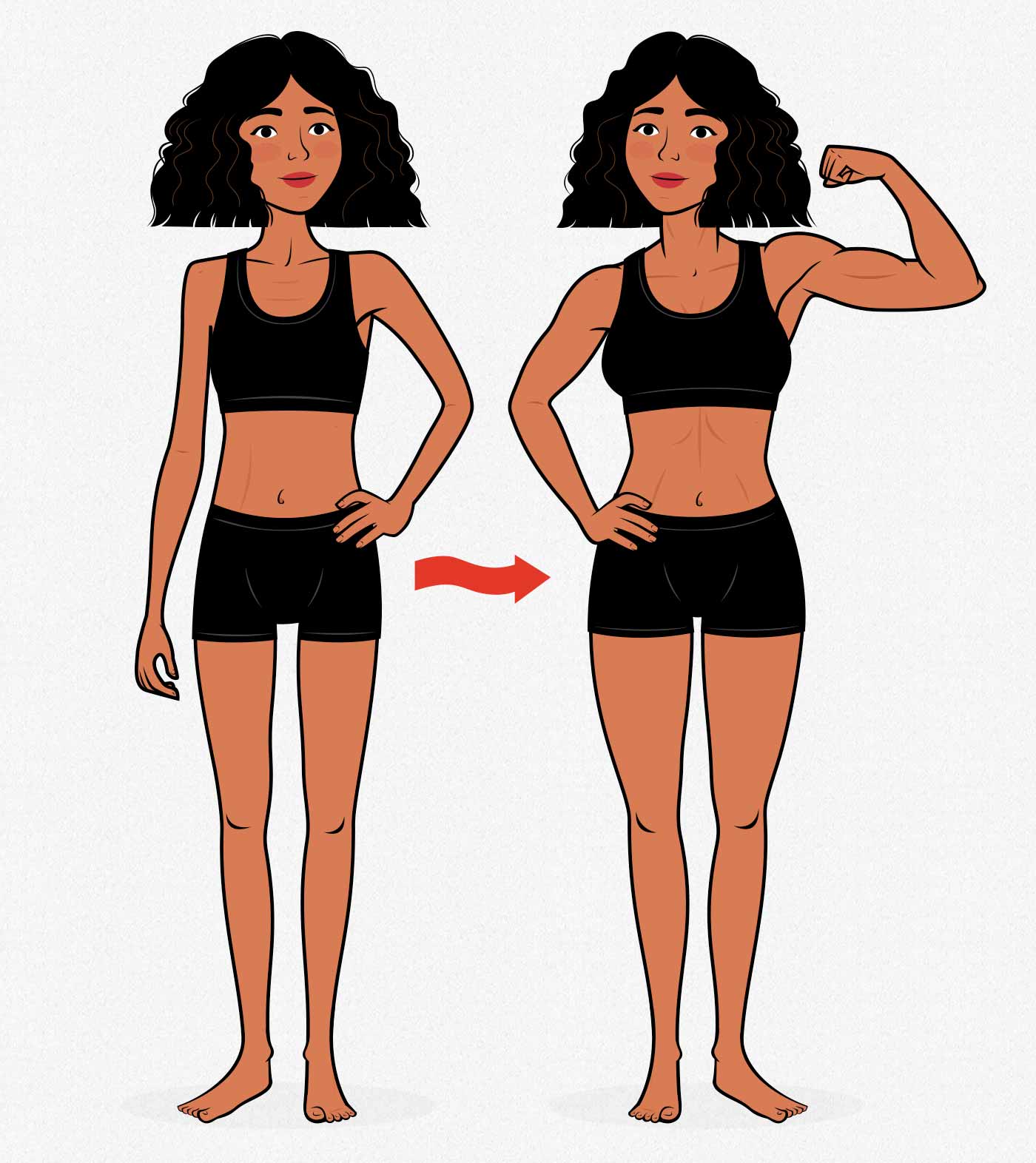
An Introduction to Hypertrophy Training
Hypertrophy training means “growth training.” It’s the type of exercise you do to build bigger, stronger muscles. It’s perfect if you’re thin and trying to gain weight, but it’s important for everyone.
It’s the default type of strength training recommended by most health experts and health organizations. When you hear the World Health Organization telling everyone to lift weights at least twice per week, they’re talking about hypertrophy training. They’re recommending a workout routine exactly like this one.
It’s also the best type of exercise for improving your appearance. Cardio is better for burning fat and shrinking your waist, whereas hypertrophy training is better for building muscle and developing a stronger, curvier, and more athletic physique.
A good hypertrophy training program looks like this:
- Weight Training: It’s possible to build muscle with bodyweight exercises, resistance bands, or other gadgets, but you’ll do far better with some combination of weights, exercise machines, and cables. If you want to do it at home, I recommend getting a pair of adjustable dumbbells. You can follow this workout plan or even our full transformation program with just dumbbells.
- Compound Exercises: Most of your muscle growth will come from getting gradually stronger at the big exercises, such as: squats, Romanian deadlifts, push-ups, and rows. Hip thrusts are good if you want extra glute stimulation. You can do those exercises with a barbell or dumbbells. What matters is that you push hard now and lift even more weight next time.
- Isolation Exercises: Most of your growth will come from compound exercises, and some of your muscles (like your glutes) will get fully stimulated by those compound exercises. But you can also target specific muscles with isolation exercises, which can sometimes help them grow even faster.
- Proper Workout Programming: This workout program will have you doing 5–30 repetitions per set, taking those sets close to failure, resting 1–3 minutes between sets, doing 3–8 sets per muscle per workout, and training each muscle 2–3 times per week. That’s absolutely perfect for building muscle.
- Progressive Overload: Write down how much weight you lift, how many reps you get, and then try to do better next time. Always try to outlift yourself. If you can do that, you can be confident you’re building muscle and gaining strength. I explain all the nuances here.
This is a 3-day workout routine, but you’re free to take it at a slower pace, doing two workouts per week. You won’t gain muscle and strength quite as quickly, but you’ll still make great progress, and that’s still enough to reap all of the long-term health benefits.
Another option is to work out three days per week when you’re trying to gain muscle and strength as quickly as possible, and then ease back into a two-day routine during periods of your life when you’re happy making slower progress.
The foundation of the routine has just four exercises per workout. These four exercises work all of the major muscles in your body, and they can be loaded progressively heavier as you get stronger.
To pick up a kid, you squat down and pick them up. If you want to carry your share of a couch, you deadlift it. If you want to push someone away, that’s a push-up. And if you need to climb up something, that’s a row or a pull-up. If you get strong at these movements, you’ll be strong at everything.
Each workout should only take you about 45 minutes. However, you’re free to add extra exercises afterwards if you’d like. You could add in some extra hip thrusts for your glutes, some biceps curls and triceps extensions for your arms, or maybe hop on a cardio machine for 20 minutes.
The Best Beginner Exercises
Beginner exercises are simpler, quicker to learn, and make it intuitive to lift with good, safe technique. They aren’t easier, less painful, or less effective. You’ll get faster results by starting with exercises like these. You’re not being a wimp for beginning with a beginner routine.
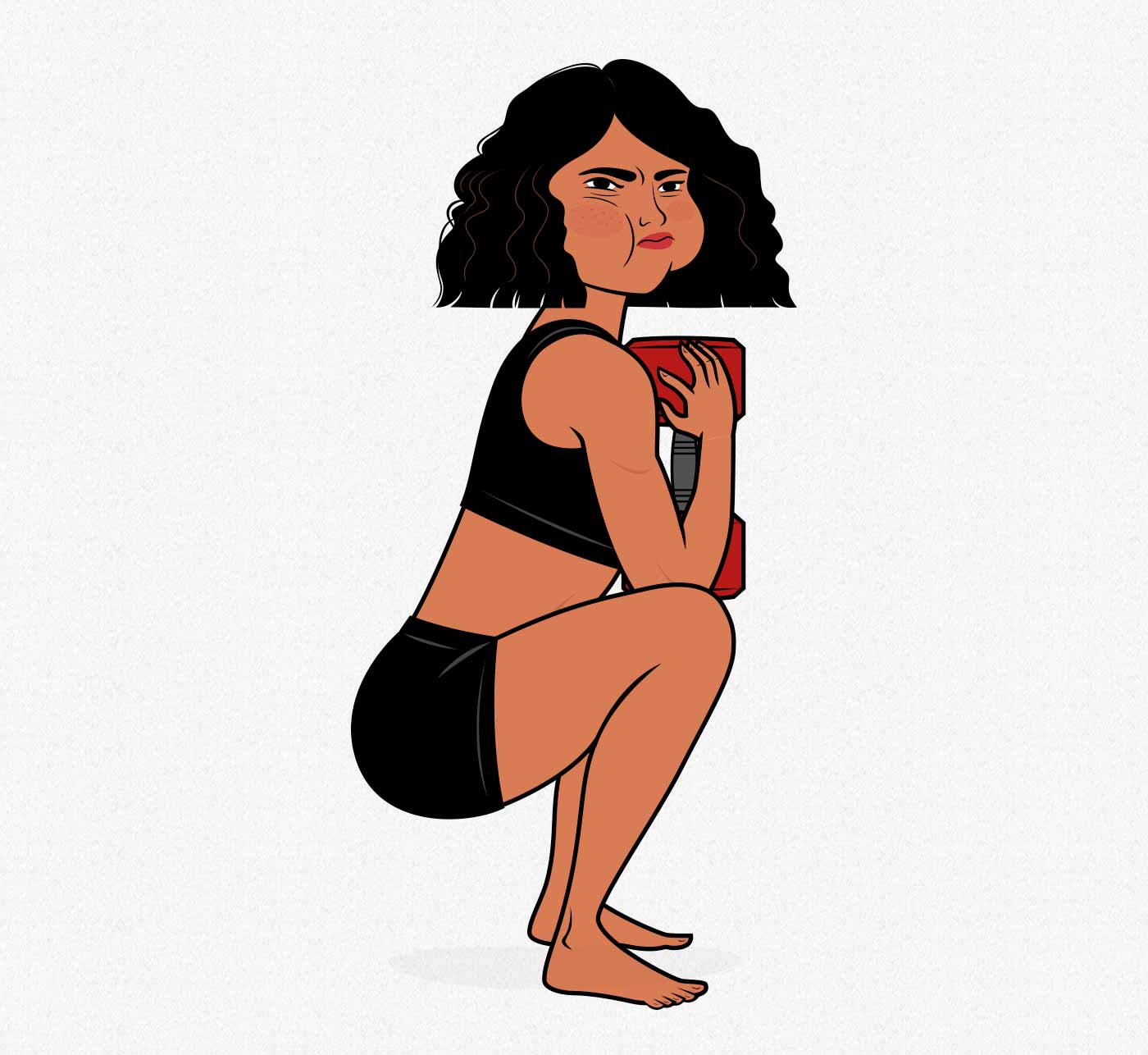
For example, goblet squats (above) have you holding the weight in front of your body, forcing you to keep a more upright torso, which makes it easier to get more bend in your knees. This makes squatting feel more natural and intuitive. And that’s good. It means you can push yourself harder sooner, stimulating more growth in your butt and thighs.
The “downside” of the goblet squat is that you have to hold the weight in front of you instead of resting it on your back. That demands more strength from your arms and core muscles. You’re working more total muscle mass. That’s good in the sense that you get more stimulus, but it’s harder.
It’s a brute strength exercise. It’s simple but difficult. And there’s nothing better for transforming your physique. If you could do just one exercise, this would be it.
But I recommend starting with at least four exercises:
- Goblet squats are an exercise for your glutes and quads, but it will also strengthen your core, straighten your posture, and build stronger arms. You can do them with a dumbbell, kettlebell, or weight plate.
- Romanian deadlifts are an exercise for your hamstrings and quads, rounding out your lower-body training. They also strengthen your lower back, your entire back, and your grip. You can do them with dumbbells or a barbell.
- Push-ups (or bench presses) work your chest, shoulders, triceps, and core muscles. They’re great for building upper-body strength and improving posture. Most people start with their hands raised on a counter or bench to make the exercise easier. The goal is to work your way down to the floor over the coming weeks and months.
- Rows (or pulldowns and chin-ups) work most of the muscles in your back, and they also work your biceps and grip. You can do them with dumbbells or a barbell.
Note that there are two exercises specifically for your glutes, which means your glutes will grow fast. You’re free to add extra glute exercises, but you don’t have to. The muscles that are being worked the least are your arm muscles.
Let’s go deeper into each exercise.
The Four Big Compound Exercises
Goblet Squats
Here’s Marco and Simone teaching the goblet squat. Don’t be discouraged if it takes you a little while to master. You don’t need to be perfect on your first day. Just strive for gradual improvement.
Notice how Simone lifts the weight smoothly and explosively. There’s no jerking, but she’s also lifting the weight quickly and with confidence, putting her full strength into it. Then, on the way down, she’s keeping the weight slow and under control.
Romanian and Dumbbell Sumo Deadlifts
Here’s Marco and Marielle teaching the dumbbell sumo deadlift, an even easier variation you could start with. It’s great for learning how to hinge at your hips, and it’s super safe and easy on your lower back.
Once the dumbbell sumo deadlift feels smooth, you can advance to the Romanian deadlift, using either dumbbells or a barbell. It’s another great beginner deadlift variation, and it’s arguably the best exercise for building bigger hips, stronger glutes, and better posture.
You don’t ever need to advance beyond Romanian deadlifts. You can keep loading these gradually heavier forever. But at some point, you might want to try conventional and sumo deadlifts. Those are even better for your glutes at the cost of being slightly worse for your hamstrings.
Raised and Regular Push-Ups
Here’s Mirielle teaching raised and regular push-ups. Whichever variation you’re doing, the important thing is to push hard, squeezing out reps until you can’t do another. And then next workout, try to do slightly more.
Once you’re able to do 20 push-ups on the floor—no small feat!—you can switch to the bench press if you want. The main advantage of the bench press over the push-up is that it’s easier to add a little bit of weight every week. The bench press is also easier on your abs and won’t feel quite as tiring.
If you want to stick with push-ups, you could just as easily switch to more advanced variations, such as the deficit push-up.
Rows, Pulldowns, and Chin-Ups
This is the dumbbell row. There are many different ways to row, and many of them are great, but this is one of the simplest variations to learn.
Once you get comfortable doing these rows, you can start practicing the lowered chin-up. And from there, you can transition to doing full chin-ups.
If you’re training at a full gym, another option is an underhand lat pulldown. It works similar muscles to the chin-up, but it’s a bit easier to learn. It makes for a good place to start, and it remains effective forever.
You’ll be doing some variation of row, chin-up, or pulldowns three times per week. You can pick your favourite and practice it until you master it. Or you can alternate between the different exercises.
The Workout Routine
The Workout
When you’re first learning how to lift, it helps to get a lot of practice. Doing every exercise three times per week is ideal for that. You’ll get good at lifting quickly. You’ll gain muscle and strength quickly, too.
Another advantage of spamming the best exercises is that it makes the workout plan incredibly efficient. You’re lugging out the biggest guns every single workout, stimulating a tremendous amount of growth.
Here’s the workout routine:
- Goblet squats: 2–4 sets of 10 repetitions.
- Dumbbell rows: 2–4 sets of 10 repetitions.
- Raised push-ups: 2–4 sets of as many reps as possible (AMRAP).
- Romanian deadlifts: 2–4 sets of 10 repetitions.
Don’t worry too much about getting exactly ten reps. Your muscles won’t mind if you fail at 6 or 15 reps. Six reps is slightly better for gaining maximal strength. 15 is a little better for improving your muscular endurance. Both are equally good for building muscle, gaining general strength, and improving your health.
It’s okay if you get 12 reps in your first set, 11 in your second, 9 in your third, and then barely manage 8 in your fourth. In fact, when you’re losing reps from set to set like that, that’s a good sign you’re pushing hard enough.
What matters is that you push yourself hard now, then try to lift a little bit more next week. You could lift a little bit more weight or try for extra repetitions. If your form felt off, you could try to lift with better technique. The important thing is to always try to outlift yourself.
I recommend downloading this free workout spreadsheet. It’s programmed into Google Sheets, which means you can open it in any internet browser or phone. The workout sheet lets you pick your exercise variations, tells you how long to rest, how many sets to do, and lets you fill in how much weight you’re lifting and how many reps you get.
GET THE GOOGLE SPREADSHEET OF THE
FREE BEGINNER’S FULL-BODY WORKOUT For Women
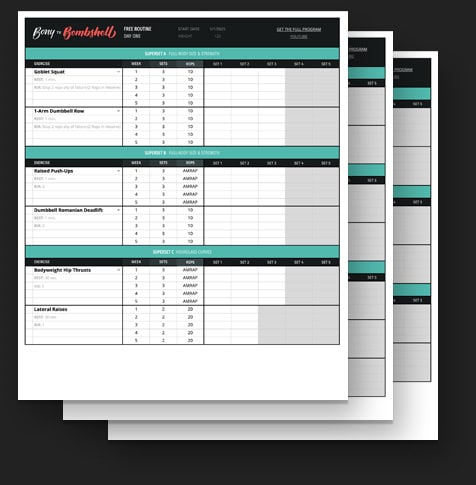
Get the workout as a Google spreadsheet. You’ll be able to pick from exercise alternatives, fill out the sheet, and get our beginner’s warm-up.
Plus, we’ll make sure you’re on the Bony to Bombshell newsletter, and send you all of our best women's muscle-building content.
Choosing the Right Weight
Everyone starts with a different amount of muscle and strength, so everyone will need to start with a different amount of weight.
The best way to find the right weight is to start much too light. Grab a weight you think you might be able to lift for thirty repetitions, but stop at ten. That will get some blood flowing and give you a bit of practice. You’ll get a feel for how strong you are, too. Then grab a heavier weight and do another ten reps. See how that feels.
Keep doing gradually heavier warm-up sets until you hit muscle failure at around 8–12 reps. That’s your first set. Write down how much weight you lifted and how many reps you got. Rest for two minutes, and then do your second set. Write down how many reps you got.
If you downloaded the workout sheet, you can write it in there. I like to write weight × reps, so if I’m lifting 80 pounds for 10 reps, I’ll write 80×10.
When you repeat the workout, look at your workout sheet to see how much weight you lifted and how many reps you got. Your goal is to lift a slightly heavier weight or get slightly more reps than last time. You might not be able to, but it’s important to try. Always write it down.
If I got 80×10 last week, this week I’m trying for 80×11 or 85×10. Either way, that would show progress. As a beginner, you should be able to gain strength fairly consistently from week to week.
Stop Just Shy of Failure
Failure is when you can no longer lift the weight with proper technique. If your postural muscles start to give out, you’ve hit failure. If you stop when that happens, lifting is very safe.
The dream is to learn how to stop right before you hit failure. As a beginner, though, you won’t know where failure is, so you’ll need to test it out. Try pushing yourself all the way until your muscles give out. Next time, try to stop right before that point.
As you get better at lifting weights, you’ll get better at knowing how many reps you have in reserve (RIR). You’ll notice when the weight starts to move more slowly. But for now, make sure you’re hitting failure often so you get some experience with what it feels like.
If it seems strange for a beginner to lift to failure, I’ve got a full article here.
Rest 2 Minutes Between Sets
It’s okay to rest longer if you need to. Whether you rest for two or ten minutes, you’ll still stimulate a similar amount of muscle growth. If two minutes isn’t enough, and you feel too tired (or nauseous) to exercise properly, feel free to rest for 3–5 minutes instead. There’s no rush.
The reason we recommend two minutes of rest is to keep your workouts short and dense. Your cardiorespiratory system will get a bit of stimulus, too, which is a healthy bonus. But if you need more rest or get interrupted partway through your workout, no problem. Just pick up where you left off.
If you want to blast through your workout even faster (and work your heart even harder), you can do the exercises as supersets:
- Do a set of push-ups
- Rest a minute
- Do a set of Romanian deadlifts
- Rest a minute
- Do your second set of push-ups
- Rest a minute
- Do your second set of Romanian deadlifts.
That way, you’re still giving your muscles plenty of time to recover between sets, but you’re doing another exercise during the rest period. This stimulates just as much growth as regular sets, and it’s slightly better for improving your fitness.
Start With Two Sets, Then Add More
When you first start lifting weights, your muscles will be very sensitive. It won’t take very much to stimulate tons of muscle growth, and doing too much can cause monstrous muscle soreness that can last upwards of a week. Having super sore muscles isn’t the worst thing, but it can interfere with your workouts, giving you more pains and less gains.
Your muscles will quickly get tougher, at which point they’ll be able to benefit and recover from doing more sets.
So, start with just two sets, then add more sets from week to week. I recommend doing two sets of each exercise in the first week. Practice your form, find the right weights, and take your time. Treat it like a practice day.
Next week, if you aren’t too sore at the start of each workout, try adding a set to each exercise. If that goes well and you feel ready for more, add a fourth set in the third week.
You can do as many as 6 sets per exercise, but 3–4 is usually the sweet spot. If you feel like you can handle more, then I recommend adding extra exercises instead. Hip thrusts are a good place to start, but you could also add split squats, lunges, farmer carries, biceps curls, triceps extensions, lateral raises, or whatever else you like.
If you ever start to feel worn down, or if you’re coming back after a long break, start the cycle over again, going back to just two sets per exercise.
Three Workouts Per Week
Each of these workouts will stimulate 2–4 days of muscle growth (article). You don’t need to wait until the soreness goes away before doing your next workout. That soreness should dissipate after a little warming up.
More important than how sore you are is how strong you are. You should be able to lift more weight or eke out more repetitions than last time. If you’re so sore that you can’t match your performance from the previous workout, you’re either doing too much or need an extra rest day.
Here’s a good default schedule, but feel free to adjust it:
- Monday: workout #1
- Tuesday: rest
- Wednesday: workout #2 (even if sore)
- Thursday: rest
- Friday: workout #3 (even if sore)
- Saturday: rest
- Sunday: rest (and full recovery)
Your muscles won’t fall off if you work out two days in a row. If your schedule doesn’t allow for a day of rest, it’s usually best to sandwich the workouts together instead of skipping them. The only downside is that your performance may be a bit worse in that second workout. You’ll still stimulate muscle growth just fine.
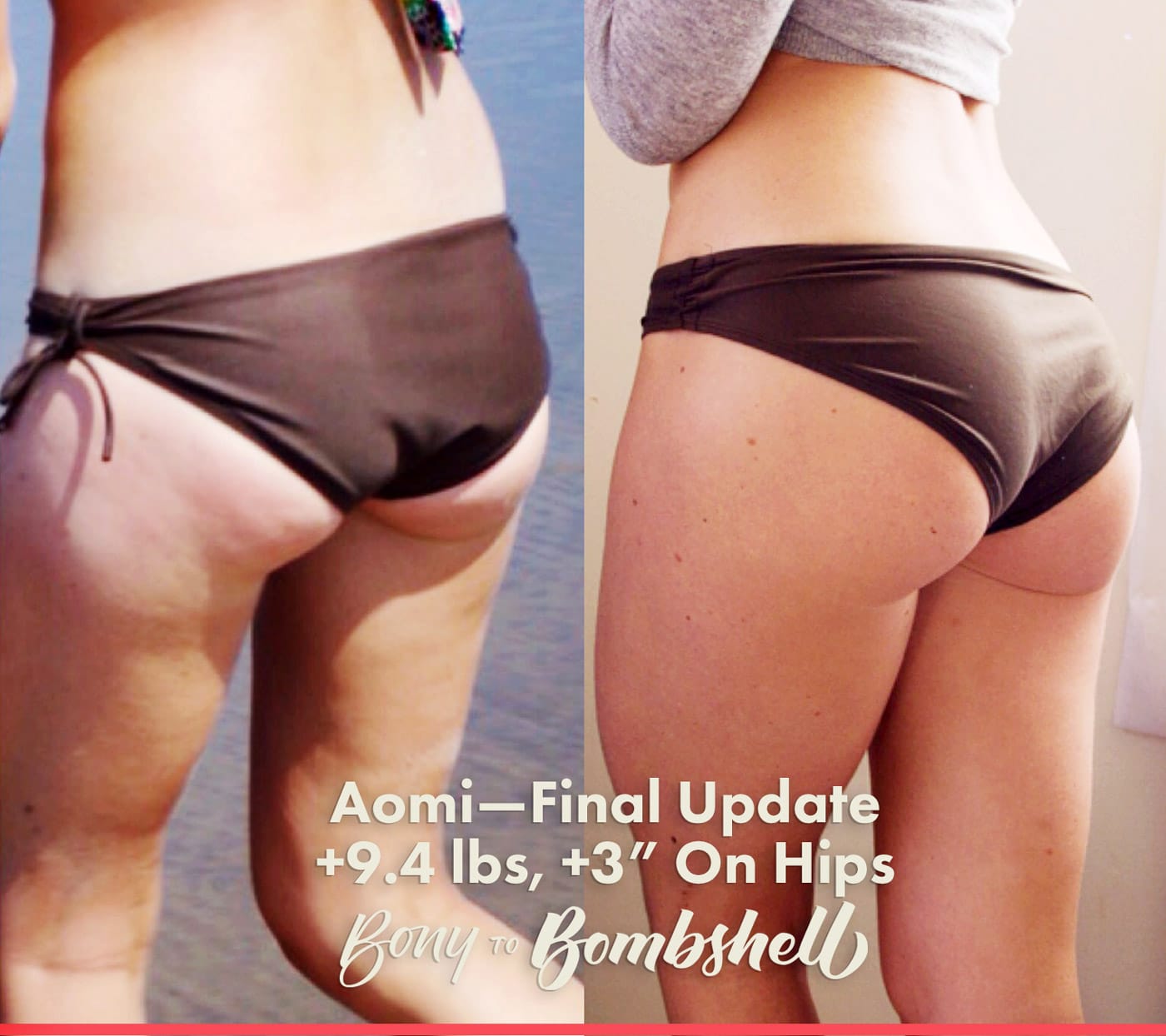
Add Isolation Lifts If You Want
This simple workout is a foundation you can build upon. You could add an arm circuit of biceps curls, triceps extensions, and lateral raises. Or you could do a core routine of planks and side planks. Or maybe 20 minutes on the elliptical.
Most women want to do extra glute exercises, which makes sense. You’re already doing squats and deadlifts, which is plenty, but adding in some extra hip thrusts or glute bridges to the end of your workout should help your glutes grow a little faster.
Barbell Glute Bridge (Barbell/Gym)
Bodyweight Single Leg Hip Thrust (at Home)
How to Support Muscle Growth
Working out is the best place to start. Worry about exercising before you worry about diet and recovery. But once you’ve done your first workout, it’s time to start eating for muscle growth.
When you’re ready, we have an article about how to eat for muscle growth.
After that, you can start tweaking other variables like getting into a good sleep routine, doing some cardio, or improving other aspects of your lifestyle.
GET THE GOOGLE SPREADSHEET OF THE
FREE BEGINNER’S FULL-BODY WORKOUT For Women

Get the workout as a Google spreadsheet. You’ll be able to pick from exercise alternatives, fill out the sheet, and get our beginner’s warm-up.
Plus, we’ll make sure you’re on the Bony to Bombshell newsletter, and send you all of our best women's muscle-building content.
What Next?
If you liked this article, you’d love our muscle-building newsletter. We’ll keep you up to date on all the latest muscle-building information for women.
If you want personal support from us, we have a full transformation program. We’ll walk you through the process of building muscle, including teaching you the lifts, giving you a full workout program, a complete diet guide, and a recipe book.
We’ll take a look at where you’re starting, set you up with a plan, help you track your progress, and give you feedback along the way. That’s how we can fully guarantee your results.

